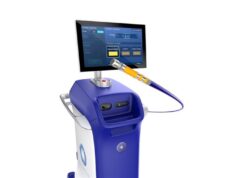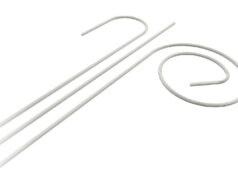
Since the implantation of the first pacemaker in humans in 1958, pacing for bradycardia has not changed substantially. While the art is mature, pacing still involves a surgical procedure to create a pocket for the pacemaker, and venous access to introduce one or more pacing leads into the cardiac chamber(s).
Lead dislodgment, pocket haematoma and pneumothorax are important implant-related complications. On the technology side, the pacing system involves a connection between the pacemaker and the lead(s), and mechanical integrity of the lead that flexes and extends with each cardiac cycle between points fixed in the heart and vascular structures.
From the patient’s perspective, there is cosmetic concern and movement restriction due to the pacemaker in his/her pocket. The most important long-term complications include lead fracture and infection, the later can range from 0.1% up to 3.5%.1-2
Finally, the presence of a pacemaker that can be seen and felt serves as a constant reminder to the patient that he or she has heart disease and is dependent on the device.
There is also a new clinical need for pacemakers to treat patients with heart failure and left bundle branch block (LBBB), which is cardiac resynchronisation therapy (CRT). In addition to standard dual chamber leads, the current device involves implanting a lead in the coronary sinus for left ventricular (LV) pacing.
While CRT is proven to improve heart failure hospitalisation and survival over optimal medical therapy, LV pacing is limited by the constraints of the coronary sinus anatomy, and the epicardial pacing site is unphysiological. The inability to choose an appropriate site, among other reasons, results in a lack of response to CRT in over 30% of patients. Should pacing to the endocardial site be possible, this will significantly improve the ease of LV pacing, and improve CRT responder.
Thus leadless pacing is not only an alternative to traditional pacemaker; it has the potential to improve CRT response. Apart from biological and transcutaneous external pacing, two principles are used to effect leadless cardiac pacing. A small electrode attached to the inside of the heart can be externally energised by ultrasound or other electromagnetic energies for cardiac simulation. Alternatively, the pacemaker can be entirely attached to the endocardium, and delivered transvenously.
Externally powered leadless pacemaker
At present, only ultrasound energy has been clinically used for leadless pacing. In an acute study3, ultrasound transmitted from an echocardiographic window was capable to reliably capture the heart at 96% of cardiac sites, including the LV and within the coronary sinus. The first implants in humans (WiCS-LV, EBR Systems) were reported in 2014.4 The device consists of a transcatheter delivered small electrode that is fixed by titanium active anchors. It is 9mm long and 2.6mm in diameter, has no battery, and is powered by an external ultrasound transmitter.
The latter receives its energy supply from a separate battery power source [Figure 1A]. In 13/17 patients who were successfully implanted, an improvement of LV ejection fraction and absence of phrenic nerve pacing were observed. However, there was a high incidence of pericardial effusion and tamponade, and transmitter failure requiring revision. Early battery depletion was a problem. The delivery system has now been improved, with the addition of an atraumatic bumper balloon at the tip of the sheath to reduce aortic valve and LV wall trauma, better ultrasound focusing and more stable structureless ultrasound transmitter. In a preliminary presentation5 with this new device in 35 patients, satisfactory CRT was achieved as a co-implant with either an ICD or pacemaker. Importantly, in a population of mainly CRT failure, the authors reported a responder rate after ultrasound pacing in over 80%.
Because of small electrode size, an external ultrasound-powered leadless pacemaker enables endocardial LV pacing that is more physiological and not limited by the constraints of coronary sinus anatomy, and opens the possibility to target an LV site that is haemodynamically optimised. The external energy source can be changed much more easily than an entirely intracardiac device. However, this requires a co-implant, and uncertainty of long-term safety of ultrasound and external interference, and thromboembolic risk for electrodes in the LV.
Entirely intracardiac leadless pacemaker
The concept of a miniaturised pacemaker with its battery and circuit incorporated in the lead and implanted entirely intracardially is not new.6 The early tests in animals used a mercury cell as power source and were not durable enough for permanent implantation. However, several technological advances have now made this concept viable. These include delivery catheters, small and ultra-low power consuming integrated circuits, and small and reliable battery source. Above all, reliable fixation mechanisms for endocardial attachment are available [Figure 1B]. Two companies have each introduced their own leadless pacemaker for use in the right ventricle (RV).
The Leadless Cardiac Pacemaker (Nanostim, St Jude Medical) is 42mm long with a maximum diameter of 5.9mm. It has an active helical screw for active fixation that also acts as the cathode, and a large anode that is the uncoated part of the device body. An implant success rate of 97% was achieved in the first 33 patients.7 Once implanted, stable pacing and sensing were achieved up to a follow-up period of 22 weeks. However, one patient had cardiac tamponade and one had inadvertent LV entry, but the device was successfully retrieved. In a study8 that now includes the first 300 patients with six months of follow-up, implant success rate was 95.8%. An acceptable pacing threshold (≤2.0V at 0.4ms) and sensing amplitude (R wave ≥5.0mV) throughout this period occurred in 90% (compared to 85% historical control). Safety endpoint of 93.3% (compared to 86%) was also achieved. Adverse events occurred in 6.7% of patients that included device dislodgement with percutaneous retrieval (1.7%), cardiac perforation (1.3%) and threshold elevation requiring retrieval and replacement (1.3%).
A different fixation mechanism is used in the Medtronic Micra TPS device [Figure 2]. It is 25.9mm long and has a maximum outer diameter of 6.7mm, weighing 2.0g. Four hook-like nitinol tines are used to fix the device in the right ventricle (RV). These tines are self-extended and catch on the endocardial surface of the RV when deployed, including through the trabeculae. The retracting memory characteristic of the tines attaches the device to the RV walls. This mechanism presses the cathode (size similar to a conventional passive pacing lead) against the RV endocardium. The ring electrode is near the proximal end of the device. It is delivered by a 23F femoral sheath, using a deflectable catheter inside this external sheath for deployment. If satisfactory electrical parameters are achieved, the attaching nylon tethers are cut, and the device deployed. Otherwise, the device can be easily re-captured and an alternative position used. To avoid perforation, a septal position (guided by contrast injection) is preferred.
The initial experience on 96 patients implanted from 19 centres worldwide has been reported.9 These patients had either class I or II indication for VVI pacemakers. Implant success was 100%. One patient had pericardial effusion but required no drainage. There were no deaths. Fifty nine per cent of patients were successfully implanted at the first RV position and 81% at the second position attempted, and all were finally implanted. The Micra TPS Global Clinical Trial was recently reported.10 In 725 patients implanted for at least six months, 96% were free from procedure and device related complications. Major complications included cardiac perforation or effusion (1.6%) and access site issues (0.7%). There was no dislodgement. The pre-specified safety endpoint (better than 83%) was achieved in 98.3%. The six-month efficacy endpoint, defined as satisfactory pacing threshold (≤2V at implant at 0.24ms and no increase of >1.5V relative to implant) was achieved in 98.3%. The implant success was 99.2%, and median implant time was 28 minutes that improved with operator experience. Compared to published studies of conventional pacemakers, the rates of major complications were reduced. The battery longevity was estimated to be about 12.5 years.
Clinical implications
The development of leadless pacing is a breakthrough in bradycardia therapy. It is an alternative to patients who require a VVI/R device. However, issues that remain to be answered include: stability of the device overtime, large-size catheters and the associated access site and cardiac traumatic complications, thromboembolic risk and durability in pacing and sensing parameters. Most importantly, in case of device complications or battery depletion, extraction and its associated risks have to be addressed. At present, with its large size, the entirely intracardiac leadless pacemaker is not applicable to the LV for CRT, nor is it useful for multiple site ventricular pacing. Atrial pacing as in a DDD device is at present precluded, both because of the size, and because of the need of leadless communication between two intracardiac but individually functioning leadless pacemakers.
Conclusion
Leadless pacing has fundamentally changed pacing practice, reducing lead related complications and changing pacing procedure. It will likely be combined with existing pacing and ICD devices for best management of arrhythmias and heart failure.
References
Chua JD et al, Ann Intern Med 2000;133:604-8
Johansen JB et al, Eur Heart J 2011;32:991-8
Lee KL et al, J Am Coll Cardiol 2007;50:877-83
Auricchio A et al, Europace 2014;16:681-8
Reddy VY et al. Wireless LV endocardial stimulation for CRT: Primary results of the safety and performance of electrodes implanted in the left ventricle (SELECT-LV) study. Heart Rhythm 2015 14 May; Late-Breaking Clinical Trials I:LBCT01-05.
Lau CP et al, Circulation 2014;129:811-22
Reddy VY et al, Circulation 2014;129:1466-71
Reddy VY et al, N Engl J Med 2015;373:1125-35
Ritter P et al, Europace 2015;17:807-13
Reynolds D et al, N Engl J Med 9 November 2015 DOI: 10.1056/NEJMoa1511643
Chu-Pak Lau is with the Cardiology Division, Department of Medicine, Queen Mary Hospital, the University of Hong Kong, Hong Kong SAR, China









